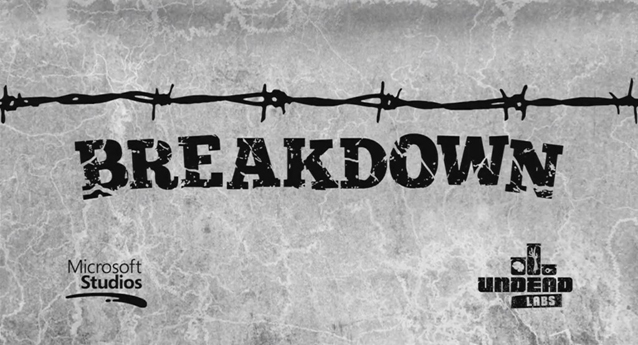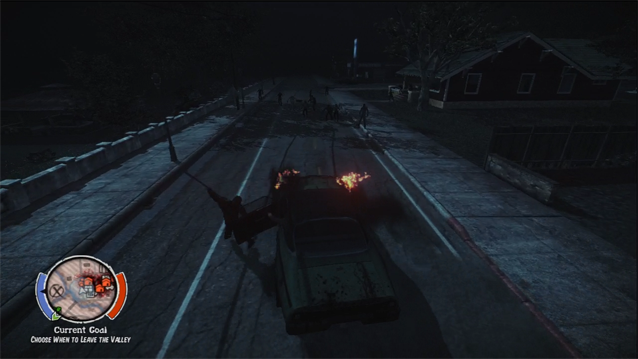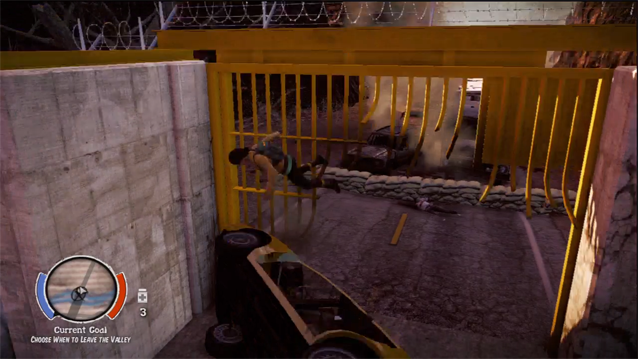State of Decay: Breakdown review (XBLA DLC)
The State of Decay: Breakdown downloadable content for State of Decay was developed by Undead Labs and published by Microsoft Studios. It was released November 29, 2012, on the Xbox 360 for $6.99. A copy was provided for review purpose.
As Undead Labs’ first dose of downloadable content for the infectious zombie-apocalypse simulator State of Decay, State of Decay: Breakdown is more companion piece than linear expansion. It sidesteps the plot progression of the original, offering instead the chance to drop into the heart of Trumbull Valley to scavenge, fortify and eventually escape, with no strings attached. Breakdown is the missing piece of Labs’ initial equation: an endless nightmarish wasteland that ramps up the difficulty with every hard-earned departure, for as long as you can take it.
To facilitate this grim cycle of survival, you’re issued a random survivor and a broken down recreational vehicle that’s lurched to a halt at one of several random locations around the valley. Your immediate concern is a defensible shelter, where you’ll foster a community while you search for a new RV and the necessary materials to get it up and running. When you accomplish this goal and take flight from the toxic gash that’s become Trumbull Valley – that’s when Breakdown really begins.
Here’s what we liked:
Made to order – The difficulty progression on display in Breakdown is the main draw, the direct answer to an outspoken community that felt the original offering was ironically not apocalyptic enough. Undead Labs has apparently taken that criticism to heart, building Breakdown around the idea of an escalating hopelessness that caters to both weekend-warrior zombie slayers and diehard veterans that would do Cormac McCarthy proud. Successfully surviving the accelerating bleakness of every iteration rewards you with another crack at the contaminated playground, with less to work with and more to fear than the time before.
Each new cycle alters the attributes and parameters cascading behind the scenes: the strength of the undead, their numbers, their frequency and the likelihood of encountering those loosely-related freaks that can turn a run-of-the-mill encounter into a white-knuckle struggle to keep your entrails securely inside your person. These things slowly escalate with every repetition in Breakdown, compounded by the fact that vital resources become not just scarce, but rare and meaningful. You need construction materials and you need food, fuel and medicine; yet by your sixth or seventh visit to the valley, even your go-to construction site housing a half-dozen shimmering containers to search, turns up nothing but a cracked pipe and disappointment.
Making a list, checking it twice – To punctuate the potentially repetitive cycles of Breakdown, Labs has included dozens of new survivors, dubbed heroes, to the roster of potential community mates. The heroes themselves range in usefulness from doctors to ex-paramilitary, but they all bring something to the table through their diverse skillsets and default equipment. However, every hero is tied to a specific accomplishment in a laundry list of challenges that require you to perform special feats, from simply slaying a number of zombies with edged or blunt weapons to creating and researching the many upgrades in your community’s library. You’ll even be tasked with euthanizing an infuriating 400 zombies through high-speed precision car door combat.
Completing these challenges is half the battle in each playthrough, as many of them hedge on building and upgrading your community, with resources you won’t comfortably find. Since each challenge is tied to a specific Breakdown level – requiring you to complete it at or above the designated number of playthroughs – the challenges list becomes a de facto taskmaster, forcing you to outline your plan of attack for this pass through Trumbull Valley. The whole system is surprisingly addictive as each new challenge tests your skills and endurance and rewards you with a potential powerhouse of a survivor.
Here’s what we didn’t like:
Legacy issues – Simply put, many of the issues we noted in our original review are still present in Breakdown. Frame rate hiccups, texture popping, stuttering and screen-tearing, it’s all still here. Knowing the purpose of Breakdown wasn’t to address technical limitations doesn’t alleviate the nagging frustration of driving full speed across a bridge as a twisted yellow gate materializes seconds before the soul-shattering impact, vaporizing your car’s engine and sending your hero flailing through the still afternoon air. Strangely enough, knowing these issues were present in the original game and returning to them some months later has lessened the severity of their weighty burden. By this point, State of Decay’s struggle with its technical side somehow encapsulates the experience – like a dingy patina on antique furniture – there’s a thematic consistency between the woefulness of the world and the grungy quirks that pop up in its presentation.
Come Again? – Harking back to the challenges, Breakdown’s wording doesn’t always relay its intended effect. For example, there’s a challenge to destroy a number of undead with explosives. Easy enough; sounds good, right? Except that the term “explosives” doesn’t apply to mines, weapon-propelled grenades, or environmental fixtures that go boom. Through trial and error, we’ve come to discover the term “explosives” refers to handheld objects that must be thrown before they’re detonated – meaning commercially manufactured grenades and makeshift pipe bombs. It’s a small nitpick, and one that’s eventually overcome with a little ingenuity, but it’s also a waste of resources in a mode that’s designed to deprive you of resources. There are a few additional challenges that flirt with this vague wording, but most of them can be narrowed down by the steadfast survivor.
Undead Labs’ first application of downloadable content to its rabid fan base is a wholly positive, welcome addition. It is exactly what those of you wanting more State of Decay will appreciate: an unlimited romp through the cinders of society. The main issue with the original offering was the story’s climax, offering nothing thereafter but more of the same in a repeated playthrough. Despite the openness of the valley and the many areas therein, eventually you could only kill so many zombies, so many freaks, so much time.
This time around, Breakdown might offer more of the same mechanically, but its flourish of escalating difficulty will eventually kill you and everyone you care about. If you’re after more of State of Decay’s apocalyptic survival without the neat lines of a cleanly wrapped campaign, you’ll want Breakdown, knowing it is exactly what you got in the initial game, amplified to the nth degree, and limited only by your ability to survive.
Score: Buy It





